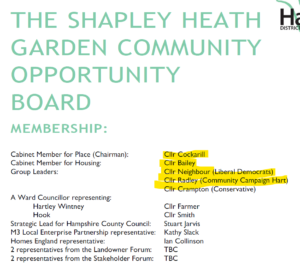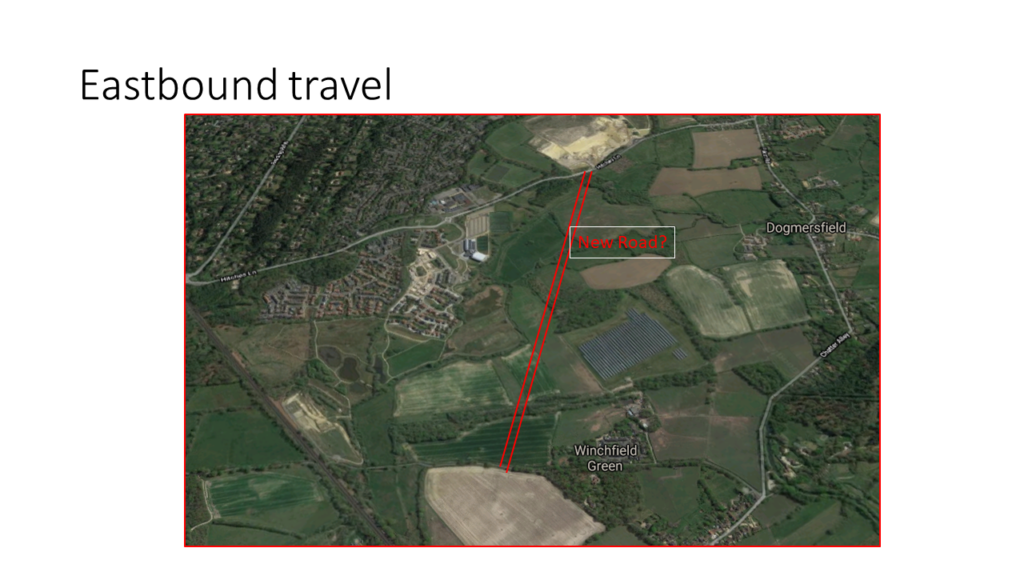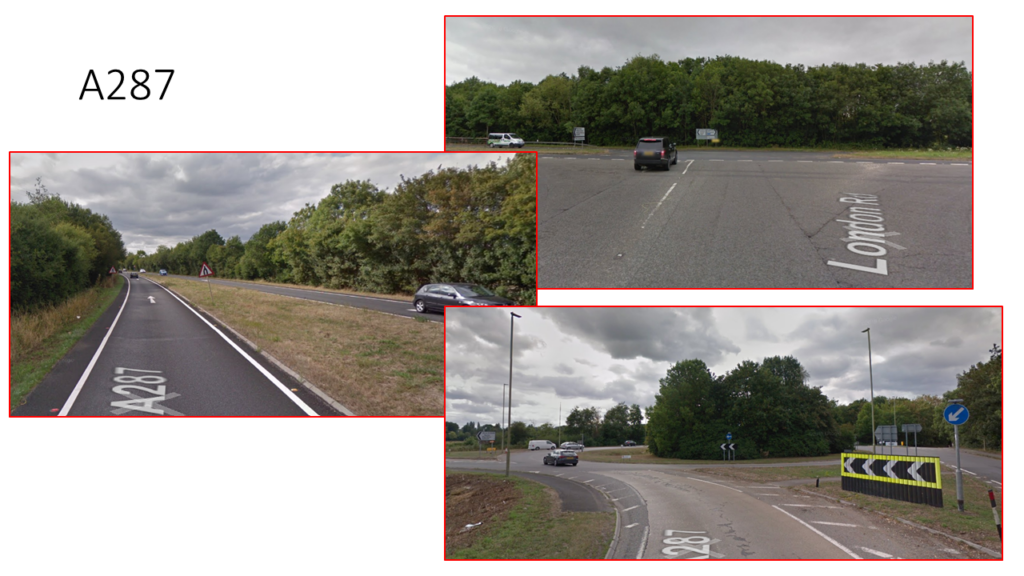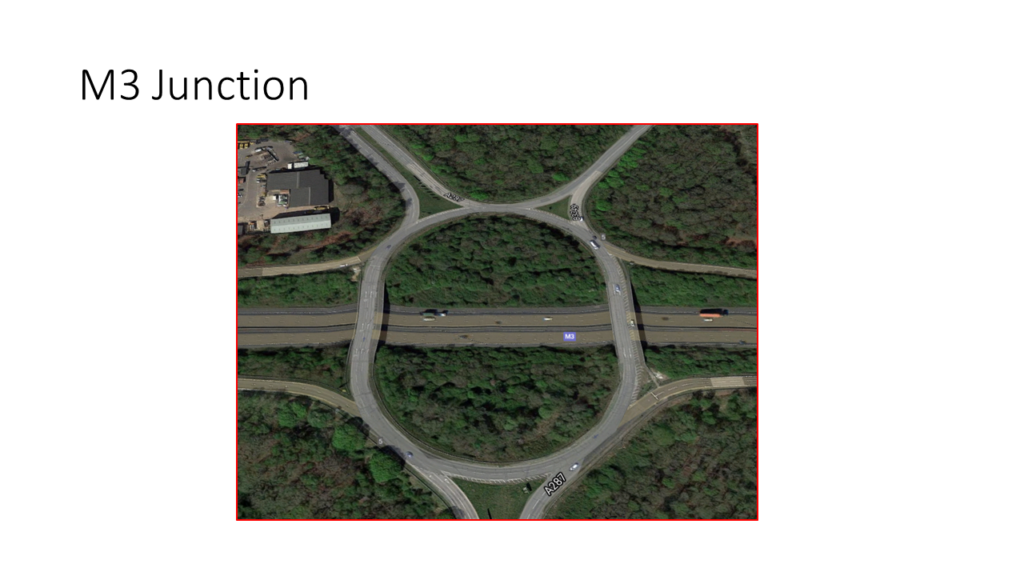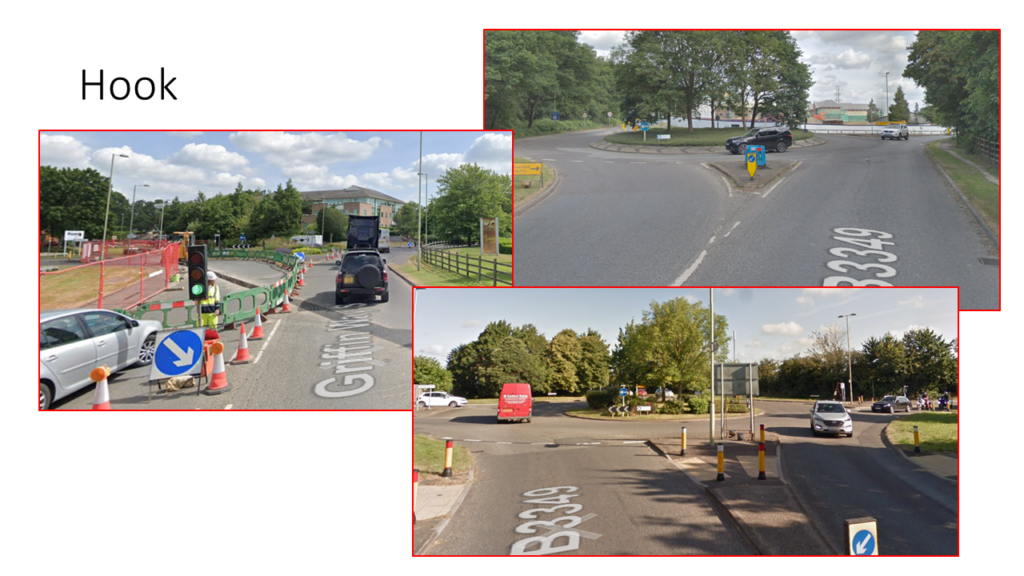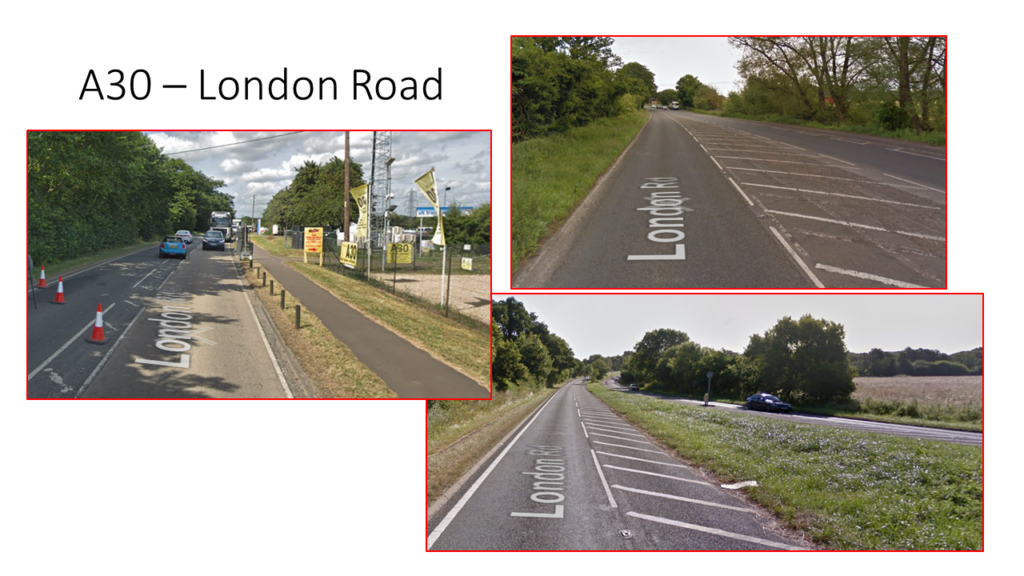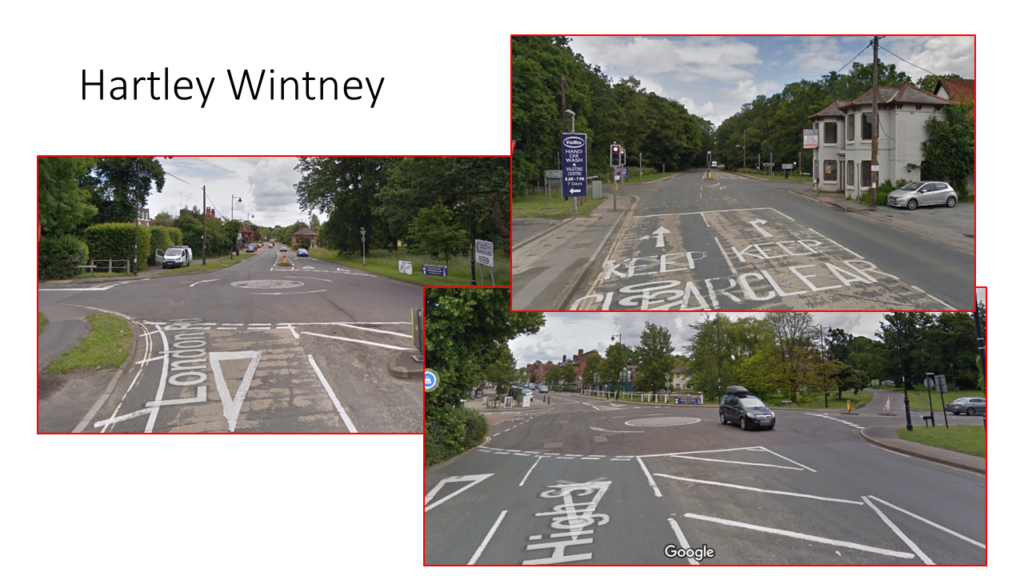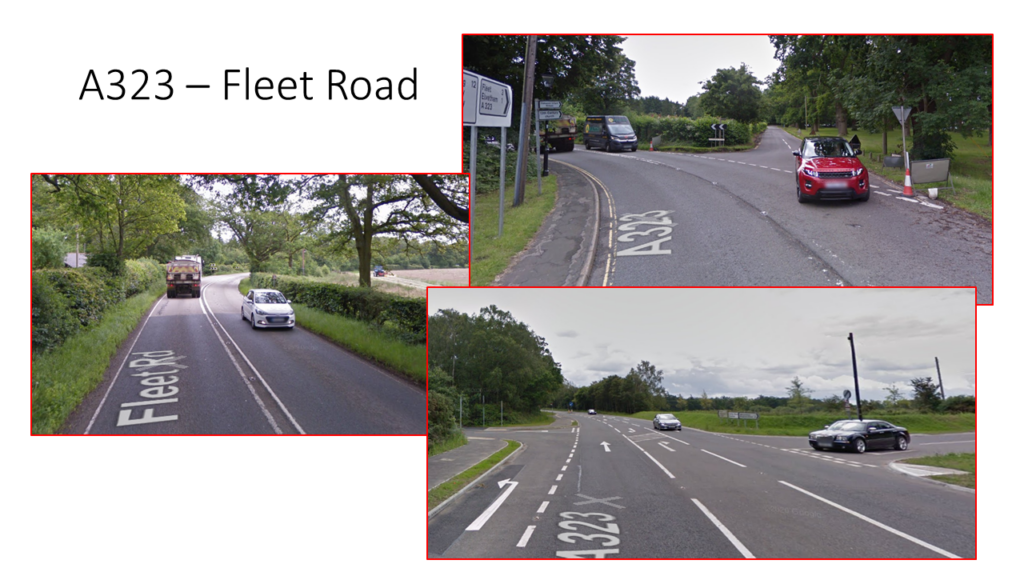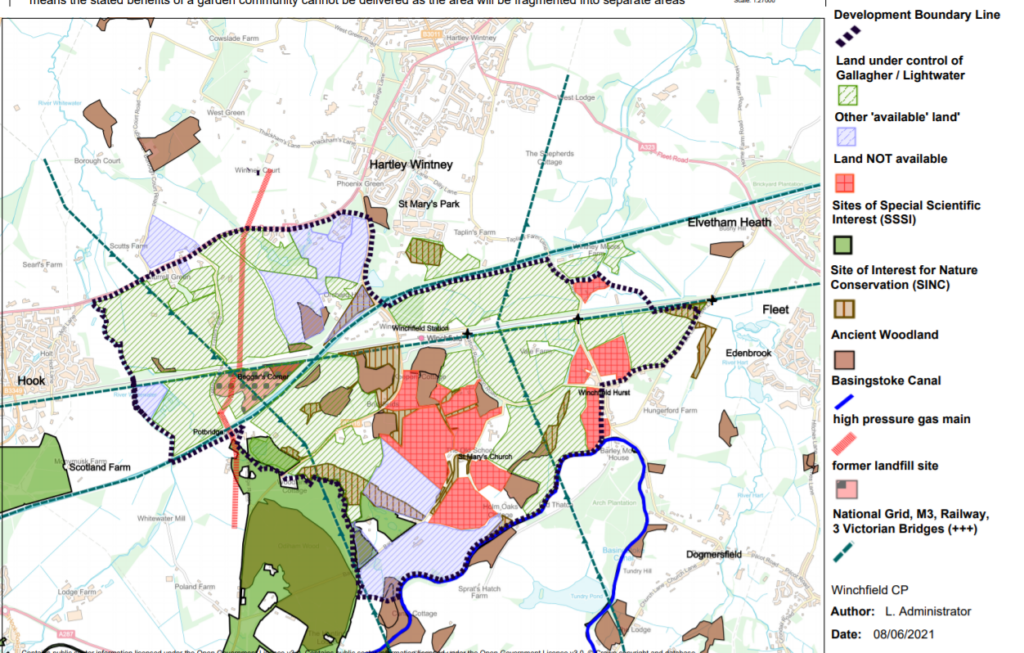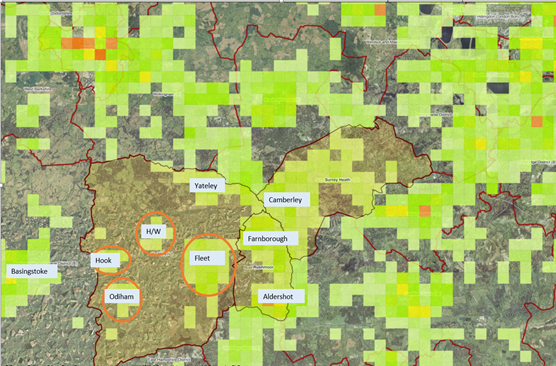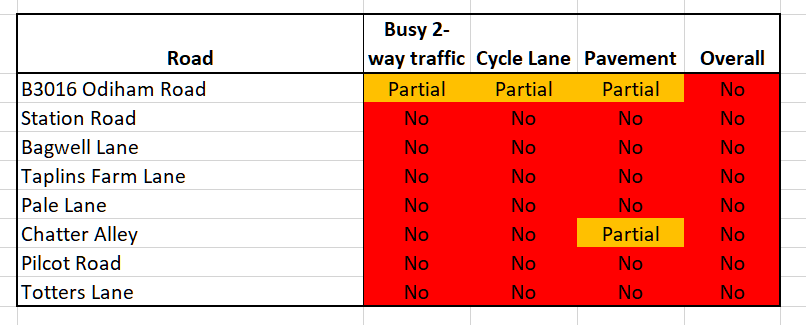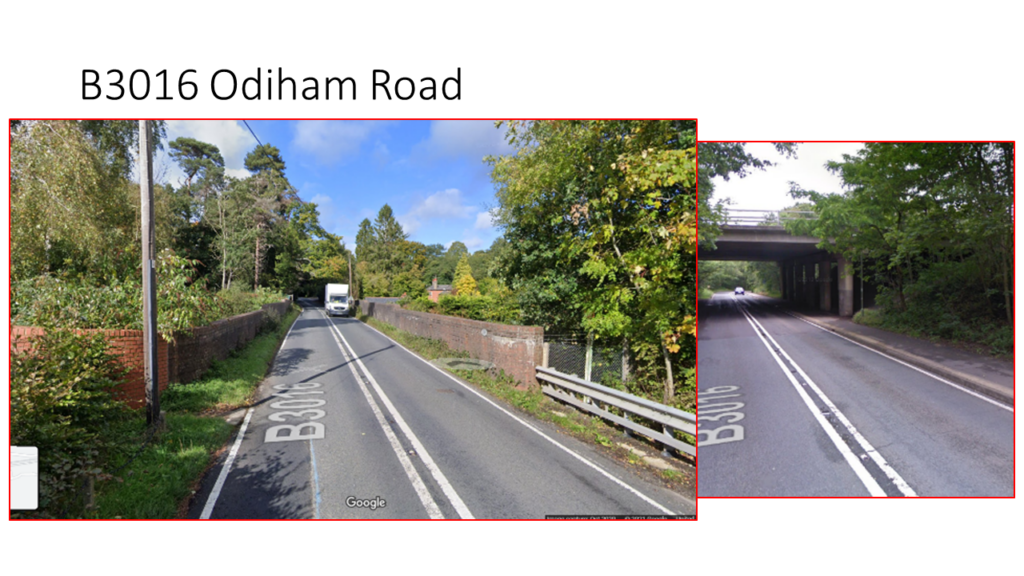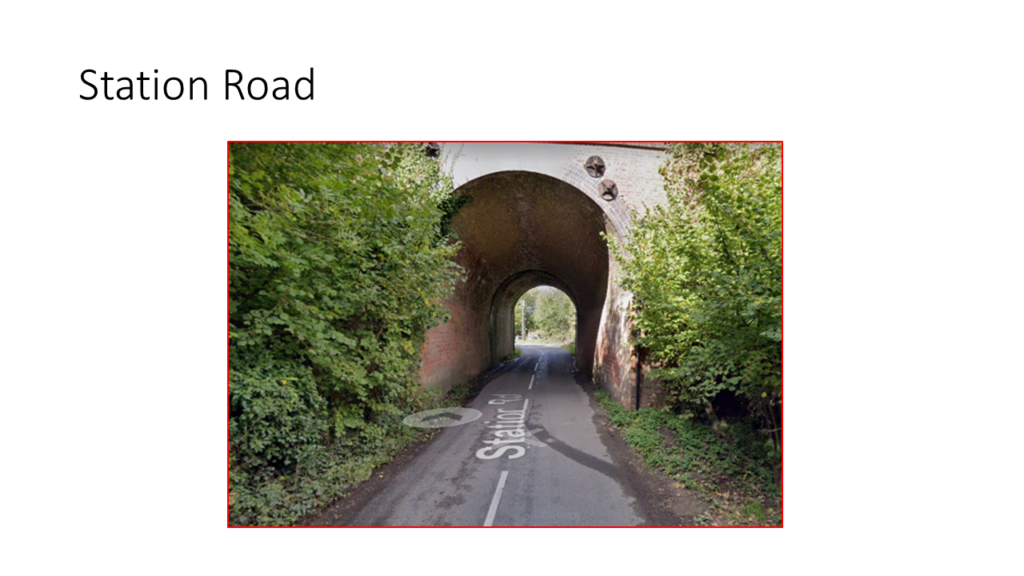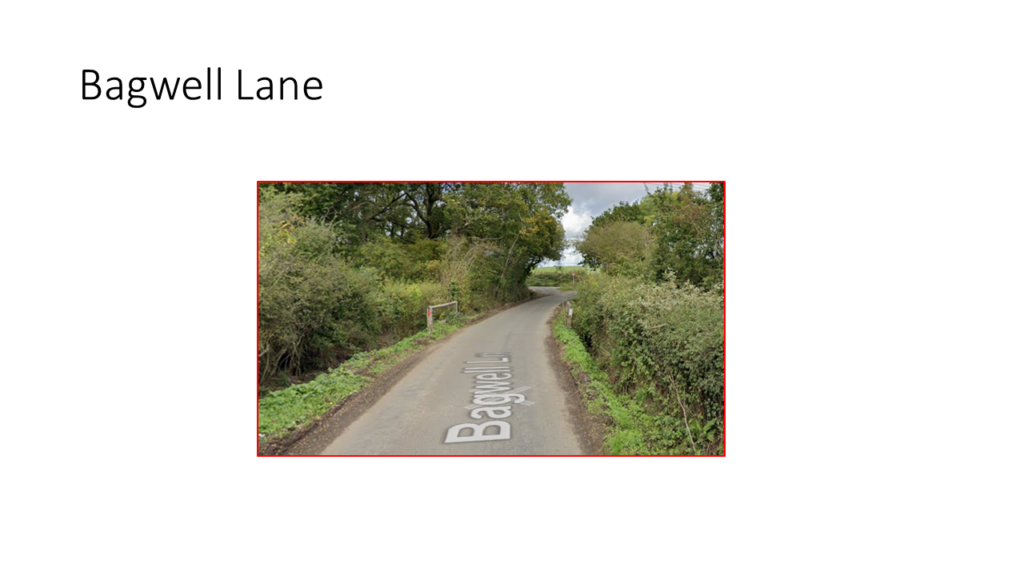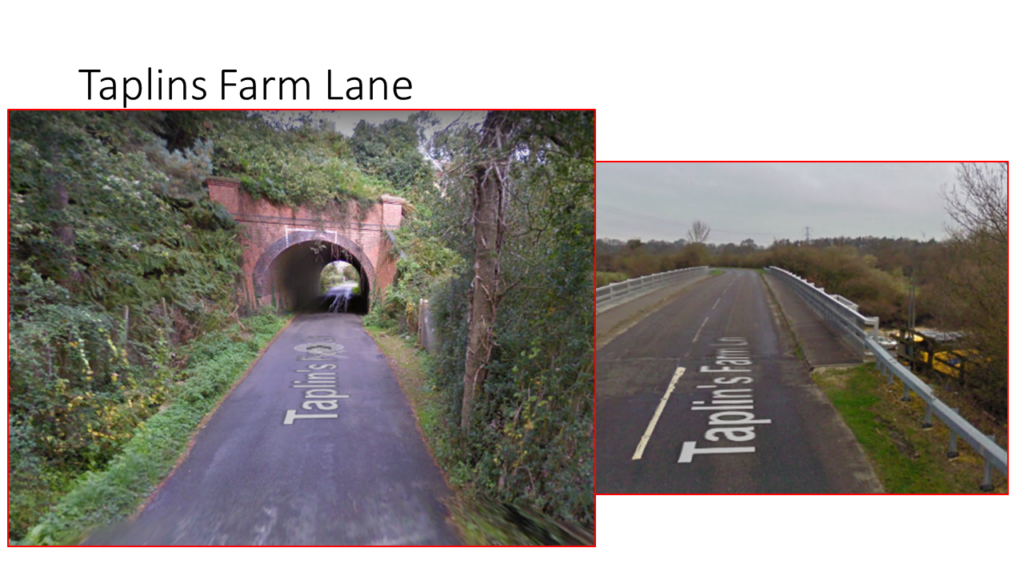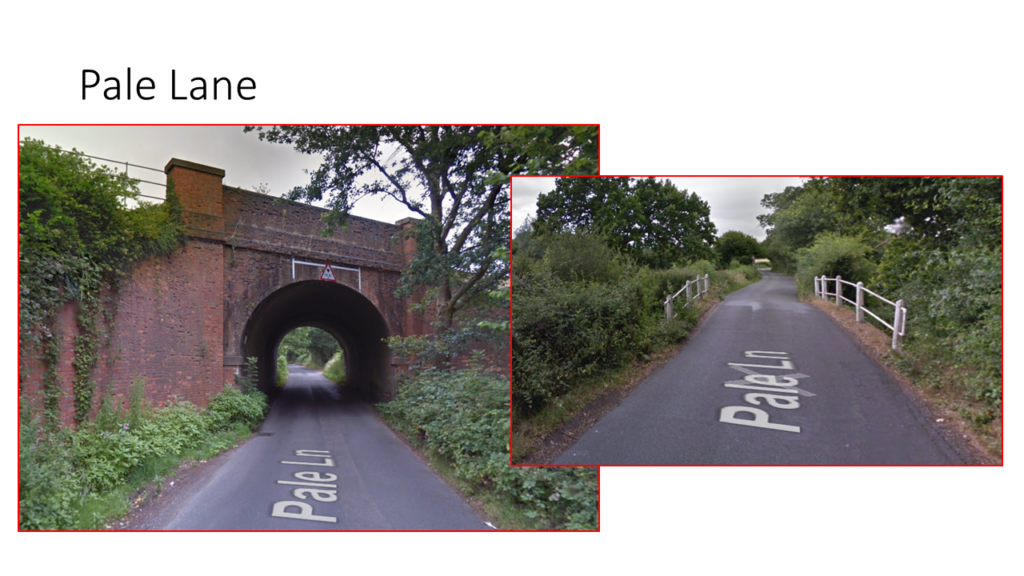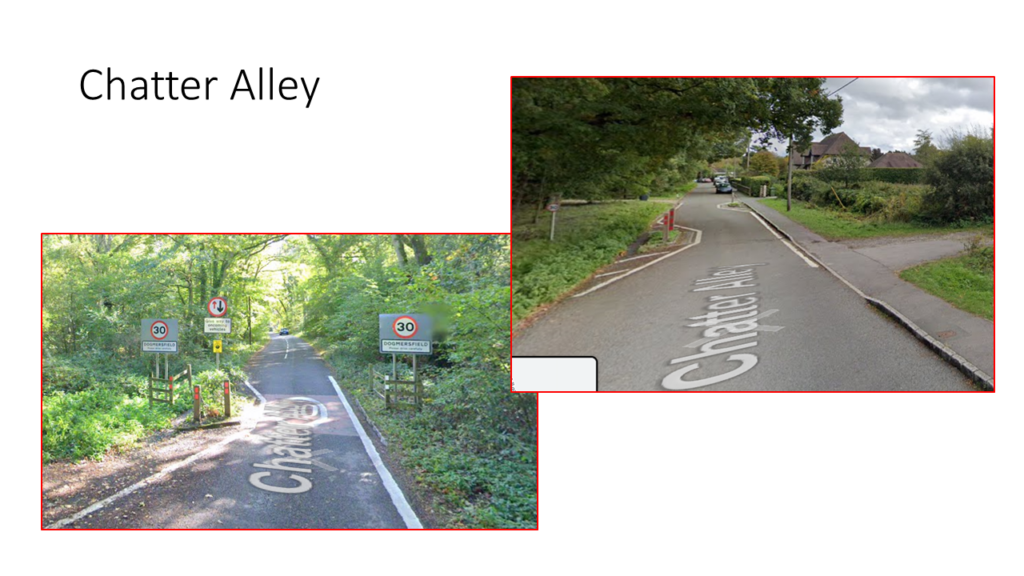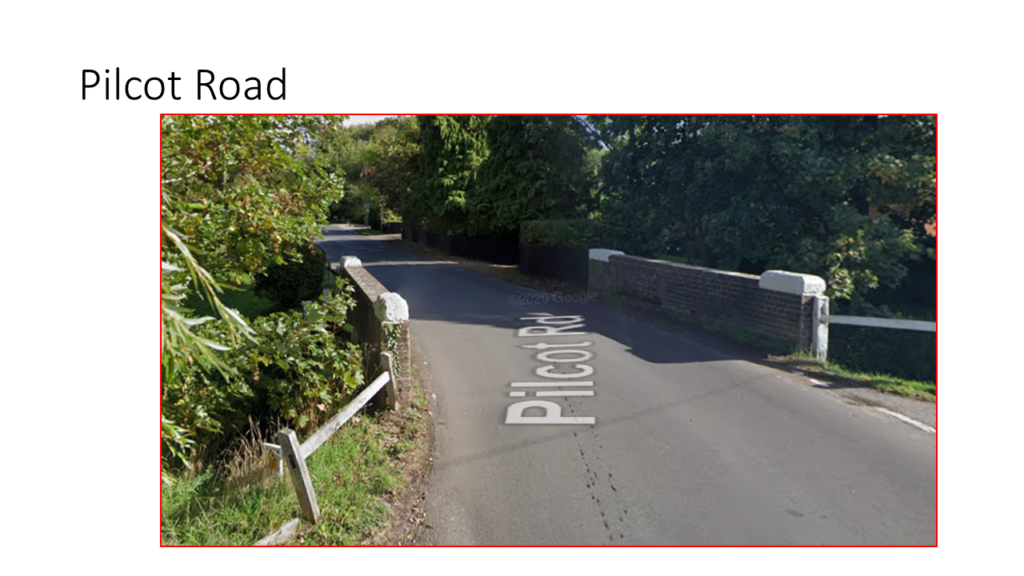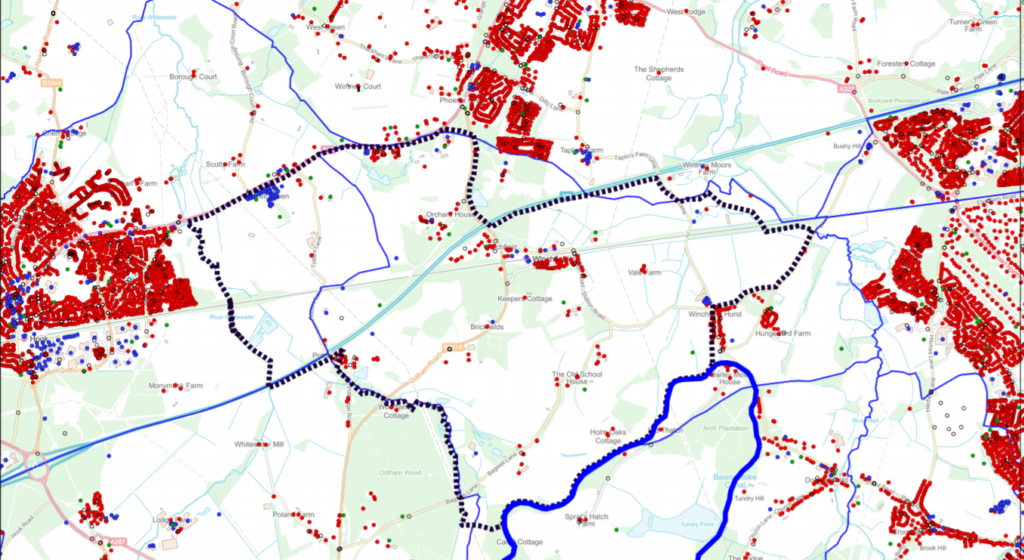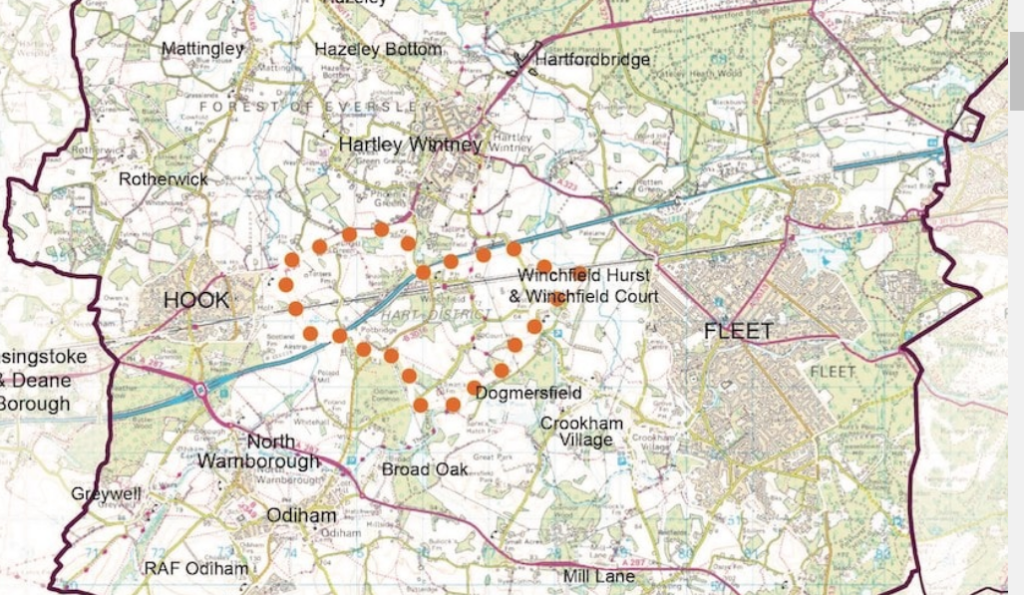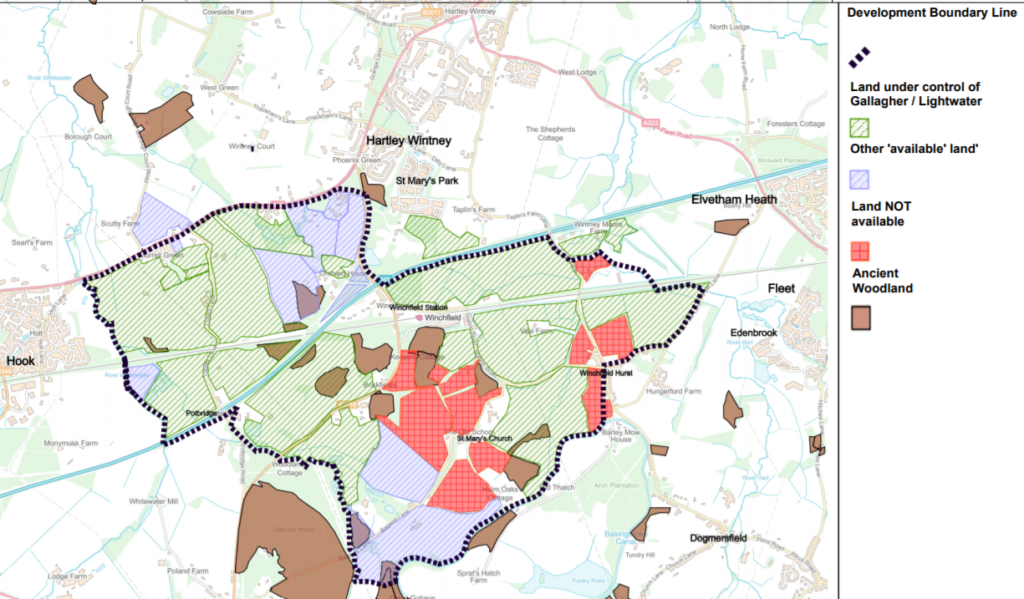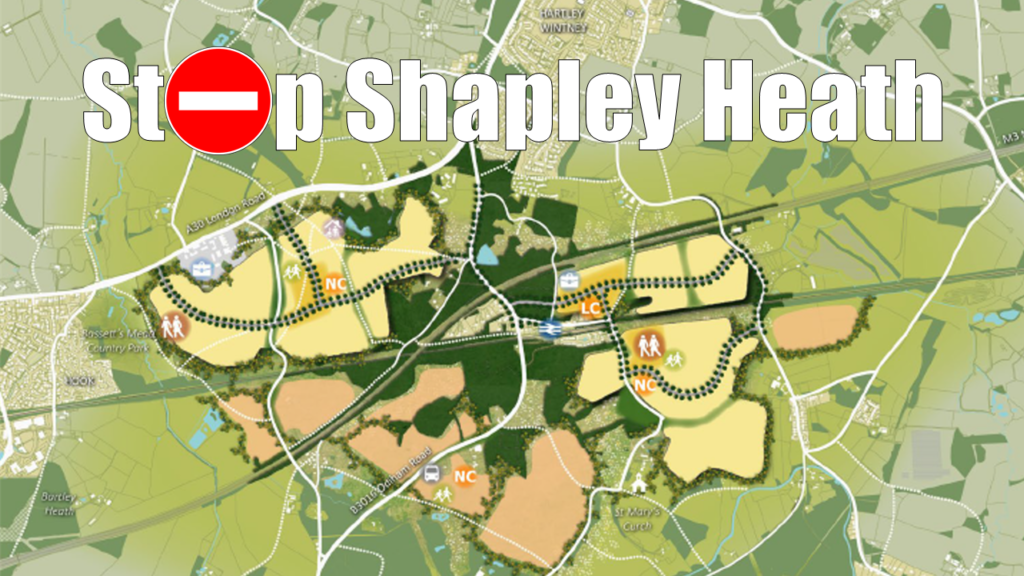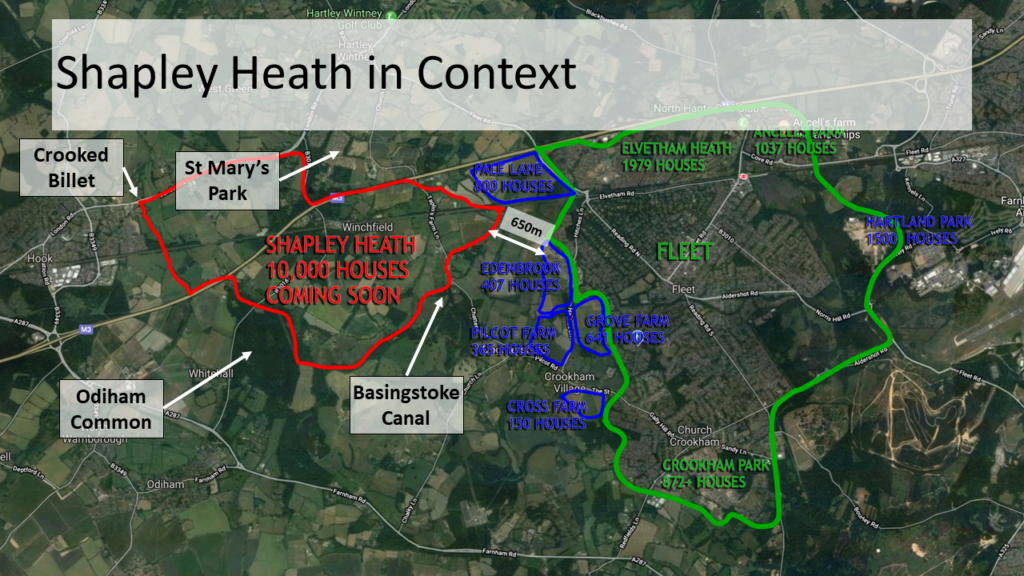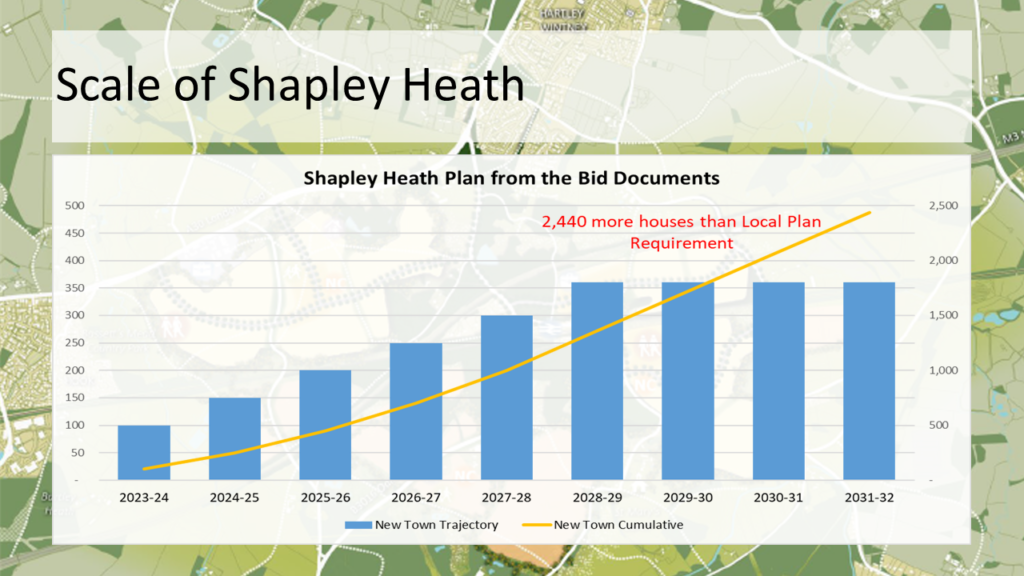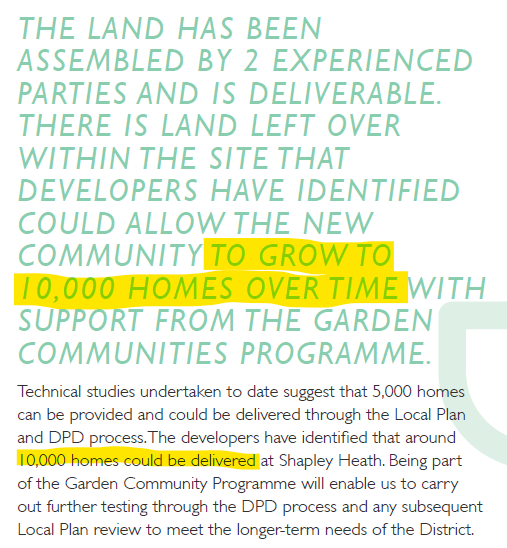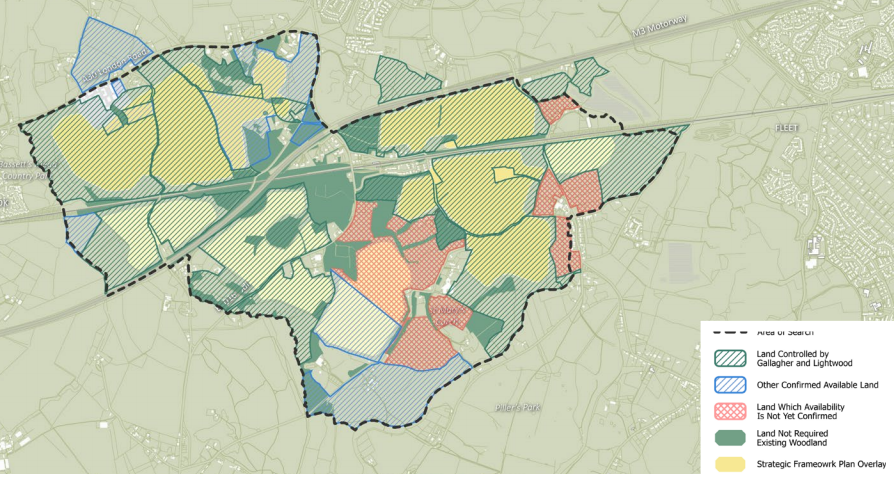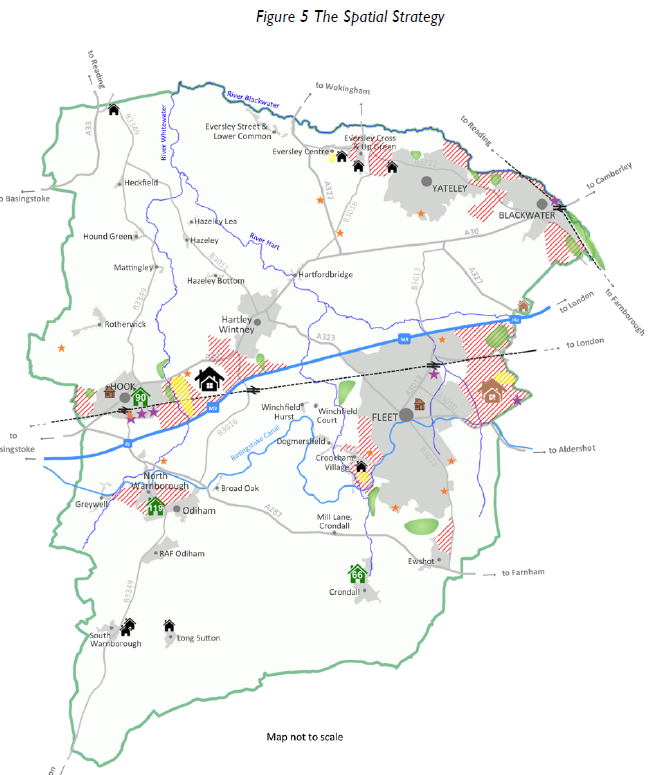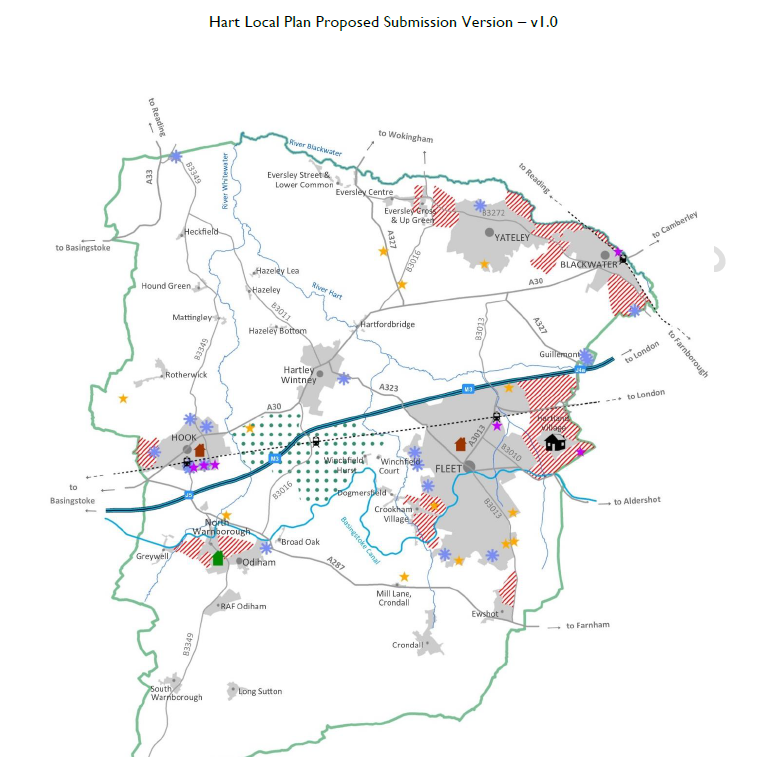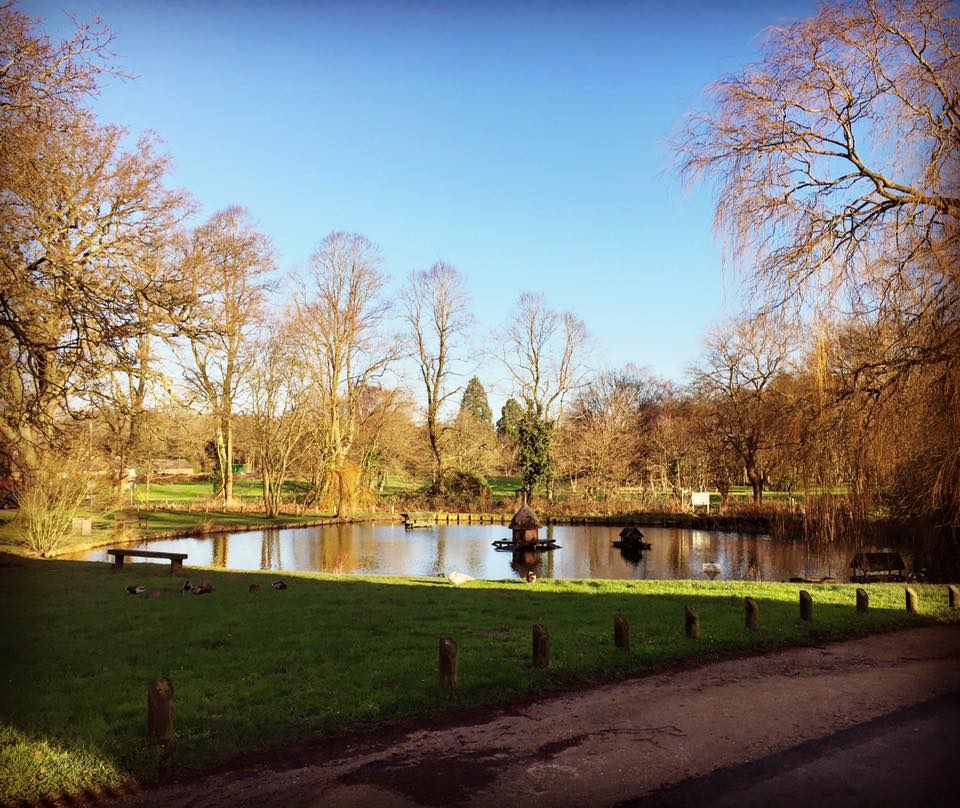We Heart Hart and Winchfield Parish Council (WPC) are fighting back against the decision to award funding for the new town.
WPC has written to the Secretary of State demanding that the decision to award £150,000 of capacity funding to support the delivery of the Hartley Winchook/ Shapley Heath garden community new town be reversed. In addition, We Heart Hart has written to MHCLG making a similar request, using slightly different arguments. We understand that the Rural Hart Association will also be making representations to MHCLG.
A summary of the WPC letter is shown below, together with links to the full text. The full text of the WHH letter follows.
Winchfield fights back: WPC Letter
The letter has the support of Hartley Wintney, Dogmersfield, Crondall, Greywell and Long Sutton & Well Parish Councils. The Parish Councils of Eversley, Odiham and South Warnborough have made known to WPC their concerns about the proposed development and will consider adding their full support to the letter when they next meet. WPC’s letter highlights the following concerns:
- The Inspector’s findings following the independent examination of the Local Plan rejected the SHGV proposal, which followed HDC’s Garden Village Application in November 2018.
- HDC’s ongoing promotion of SHGV is not supported by the Inspector’s findings on the submitted Local Plan and he is quite clear that other options need to be considered in an impartial manner.
- The absence of sound justification for bringing forward SHGV (as it is not needed to meet identified housing needs) and the lack of evidence to demonstrate that the proposal is deliverable and sustainable was confirmed by the Inspector’s findings on the submitted Plan.
- The numerous shortcomings with HDC’s bid when considered against the Garden Communities prospectus lead us to question how it has been successful.
- HDC pre-determined the plan-making process, and failed to provide the evidence to the Inspector to demonstrate that it had impartially assessed reasonable alternatives. If HDC proceed with a Local Plan review as indicated based on SHGV as its chosen long term growth strategy, it will irresponsibly overlook the Inspector’s criticisms of the current Plan’s failure to impartially assess reasonable alternatives, and continue to ignore local opinion. HDC’s bid to be included in the Gardens Community Programme is a further demonstration of their continuation of pre-determine the planning process.
- HDC’s ongoing promotion of SHGV is not supported by the local communities directly impacted by this large scale proposal.
The full text of their letter can be found here. And the appendix can be found here.
Winchfield Fights Back: We Heart Hart letter
The full text of our letter is set out below:
Dear Ministers,
Re: Hart District Shapley Heath Garden Community Funding Award
My name is David Turver. I run a campaign in Hart District called We Heart Hart. We have taken an active role in the Hart Local Plan, and I was invited to speak at the examination hearing. We have successfully campaigned against the new settlement proposal. We believe that urban regeneration and brownfield development is a much more sustainable and better way to deliver Hart’s longer term development needs.
I note that you have recently awarded £150,000 of capacity funding to Hart District Council to support the delivery of the Shapley Heath so-called Garden Village in Winchfield/Murrell Green.
I would like to share with you some extra facts which may cause you to reconsider your decision. The main letter sets out the main points, backed up with links and references in the Appendices. I have copied my local MP, the leader of the Conservatives on Hart Council and your garden communities email address so you can obtain a soft copy of this letter and follow the embedded links if required.
New Settlement Policy SS3 not required and not sound
Hart’s Garden Community bid in November 2018 relied on Policy SS3 being found sound in their Local Plan examination. Policy SS3 proposed a new settlement in the same area of search as the proposed Shapley Heath development. The Local Plan itself acknowledges that the new settlement is not required to meet Hart’s housing needs. The Planning Inspector, Jonathan Manning, found that he had “a number of fundamental concerns with regard to the soundness of Policy SS3”. As a result, Hart Council has removed policy SS3 from the Local Plan to make the plan sound. See Appendix A for more details.
More work required to make new settlement sound leading to a delay of up to five years
The Inspector has said that much more work was required to make the new settlement sound:
I am of the view that a significant level of further supporting work would be required for Policy SS3 to be found sound in its current form, which would need to include appropriate and proportionate area/site assessments, infrastructure considerations, viability testing, evidence in support of deliverability and further SA work, which would need to be done in an impartial manner with sufficient evidence to support its findings and comparisons with alternative options. Any further SA work would also need to include additional standalone consultation….
I am also mindful that following further work, there can be no guarantee that the evidence would support it as the most appropriate long-term growth strategy or that Policy SS3 would be found sound.
There are several alternative options, including alternative sites and alternative strategies such as urban regeneration. So, it is clear that a new SA would be a considerable undertaking in its own right. In the risk assessment accompanying Hart’s bid they anticipated this outcome. Their mitigation was to press-on regardless with the new settlement DPD, independent of the Local Plan. I am not at all convinced that creating a DPD outside of the Local Plan process is in line with the planning regulations.
However, the Inspector makes clear that significant SA work and a standalone consultation ought to precede a new DPD. Moreover, in Hart’s latest consultation into the modifications required to make the Local Plan sound, they have completely changed their tune. The Sustainability Appraisal Addendum says that “the AoS/DPD process will effectively be replaced by a different process, most likely a new Local Plan” (see Appendix B). The impact of this is that:
- The further SA work may conclude that there are better alternatives to delivering longer term growth. I know there are many in the District who support our local MP’s call for urban regeneration.
- Even if it is decided that a new settlement is the best long term growth option, the timescales for a new Local Plan process indicate that work on a new DPD will not start for a considerable time; maybe up to five years.
No plans to meet commitments in the Garden Community bid
In their bid, Hart committed to producing a New Settlement DPD in December 2019 if they received the Garden Community funding (see Appendix C). Yet, in response to recent questions at council, they confirmed that they have no current plans to start the additional SA work required by the Inspector; no plans to produce the New Settlement DPD and have not allocated any of the £786K budget set aside for the New Settlement in FY19/20. It might be expected that the wide scope SA work would take at least six months, plus a further 2-3 months for a consultation. It is therefore difficult to see how work can start on a new DPD this financial year. Therefore, it is difficult to see how the Garden Communities grant money can be spent effectively during this financial year.
Deceptive Communications
In addition, I am sorry to report that the Lib Dem/Community Campaign Hart led Hart Council has not been as open and transparent as one would hope in its communications on this matter. Recently, the council was asked who had been informed that Policy SS3 had been found unsound and removed from the Local Plan. Their answers stated that both Homes England and MHCLG had been kept informed prior to the funding announcement. However, a subsequent release of correspondence shows that the removal of Policy SS3 was a passing comment to an official in Homes England in an email about a different subject. There is no record of MHCLG being contacted directly. I am therefore concerned that MHCLG may not have been aware that the new settlement had been found unsound between Hart Council’s bid and the award of funding in June 2019. It would be a shame if the Government awarded money to fund an unnecessary and unsound white elephant project.
Alternative options
Quite separately, Hart made a recent bid for funds under the Future High Streets scheme and was turned down. Our local MP, Ranil Jayawardena is running a campaign to support urban regeneration within Hart.
The catalyst for this could be the publicly owned civic quarter containing the Hart Council offices and the Harlington Centre. The area is ripe for mixed-use redevelopment including offices, homes, social and retail. If all levels of Government got behind this, it would spark interest in redeveloping the rest of the High Street, including the Hart Shopping Centre.
Conclusions
In conclusion, it is clear that the facts have changed since the bid was submitted.
- Policy SS3 covering the Shapley Heath new settlement has been found to be unnecessary and unsound and removed from the Hart Local Plan.
- There are no plans to conduct the wide ranging SA work required that might bring the new settlement back on to the agenda.
- There is no guarantee that such work will conclude that a new settlement is the best option for long term growth.
- It is inconceivable that such work could be completed during this financial year, meaning that work on a new settlement DPD could not even start before FY20/21, so the funds you have awarded could be wasted.
Therefore, I would be grateful if you could review your decision in the light of new facts. There are many residents of Hart who would be pleased if the Garden Communities funds were redirected towards regeneration of our decaying urban centres instead of concreting over the very green fields that make Hart such a great place to live.
Thank you for your kind consideration of these points. I understand Hart Council representatives are meeting with Homes England this month, so I hope you have time to re-consider the funding decision before that meeting. I look forward to your prompt reply.
Yours faithfully,
David Turver
cc: Ranil Jayawardena MP (by email)
gardencommunities@communities.gov.uk (by email so the embedded links work)
Anne Crampton, leader of Conservative group on Hart Council (by email)
Appendix A: – Hart’s Assumptions and Inspector’s Report into Hart Local Plan
Here is Hart’s bid assumption that Policy SS3 would need to be found sound in the Local Plan:

Shapley Heath funding assumes Policy SS3 remains in Hart Local Plan
The Inspector’s post-hearing letter about the examination of the Hart Local Plan can be found here.
May I draw particular attention to paras 17-39. A summary of his findings with respect to the Sustainability Appraisal and the New Settlement are shown below:
- The ranking of Option 1b (the new settlement) “as the best performing under heritage is not justified”.
- For land and other resources, the ranking of Option 1b “is also therefore not, in my view, robust”.
- The Inspector decided that “the decision not to rank the options in terms of flood risk to be very questionable”.
- On landscape issues the Inspector concluded:
Option 1b was ranked joint highest with Option 1a. However, it is unclear why this is the case, given that the proposed new settlement would result in the development of large areas of open countryside and Option 1a already benefits from planning permission and is largely previously developed land. Further, the post submission SA notes that Pale Lane is ‘relatively unconstrained’, but despite this and it being a smaller site / potential development, Option 3a is ranked lower than Option 1b.
- The Inspector has this to say on the climate change ranking:
Option 1b has been ranked the highest under the category climate change. This is as a result of the potential for the proposed new settlement to deliver a district heating system. However, there is little evidence to suggest that this is a feasible or realistic option that is being actively pursued by the site promoters. I consider this raises doubt about the appropriateness of such a ranking.
- The ranking for the impact on water was also criticised by the Inspector.
In conclusion on the SA the Inspector said:
In my judgement the scoring of Option 1b above or equal to other options is not justified by the evidence. As a result, I consider that Policy SS3 and its supporting text are not justified, as, on the currently available evidence, it cannot be determined that it represents the most appropriate long-term growth strategy.
I consider that the post submission SA is therefore not robust and should not be relied upon in support of the Plan.
In addition, the Inspector clearly states:
Given my earlier findings in terms of the housing requirement, Policy SS3 is not required for the Plan to be sound and, in light of my comments above, I consider that the most appropriate course of action would be to remove it (along with any other necessary subsequent changes) from the Plan through Main Modifications (MMs). This would allow the Plan to progress towards adoption without any significant delay to the examination process…
I consider that it would not be unsound for the Plan to retain the Council’s aspirations to plan for long-term needs beyond the Plan period, which could include the delivery of a new settlement. But, the Plan should clearly state that this, as a growth option, would need to be fully considered and evidenced in a future (potentially early or immediate) review of the Plan or a subsequent DPD…
I am of the view that a significant level of further supporting work would be required for Policy SS3 to be found sound in its current form, which would need to include appropriate and proportionate area/site assessments, infrastructure considerations, viability testing, evidence in support of deliverability and further SA work, which would need to be done in an impartial manner with sufficient evidence to support its findings and comparisons with alternative options…
I am also mindful that following further work, there can be no guarantee that the evidence would support it as the most appropriate long-term growth strategy or that Policy SS3 would be found sound.
Appendix B: Local Plan Modifications and Sustainability Appraisal Addendum
The main modification related to removing Policy SS3, New Settlement from the Hart Local Plan can be found below. The full consultation can be found here.

Winchfield Fights Back – Shapley Heath Policy SS3 removed from Hart Local Plan
The Sustainability Appraisal Addendum accompanying the consultation into the Main Modifications to the Local Plan can be found here.
I draw your attention to page 2:

Winchfield Fights Back: SA Addendum impact on Winchfield New Town Area of Search
Appendix C: Bid Commitments and Lack of Current Plans
No doubt you already have a copy of their bid commitment. Here is the commitment to produce a New Settlement DPD for consultation by December 2019.
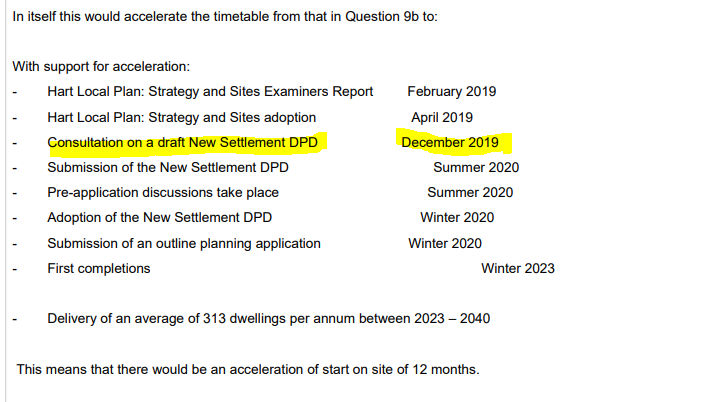
New Settlement Bid Timeline for DPD
The draft minutes from the Hart Council meeting held on 25 July 2019 can be found here. I refer you to Q&A in Appendix A.
Here is the response that shows no plans to carry out the additional SA work required by the Inspector:
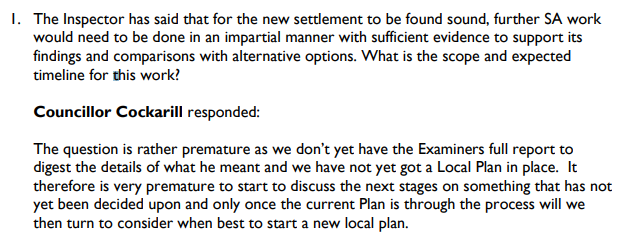
Winchfield fights back: No plan for SA work
No plans to allocate budget:

Hart Council Knows Nothing: No idea how much of £786K will be spent or when
No plans for a New Settlement DPD.
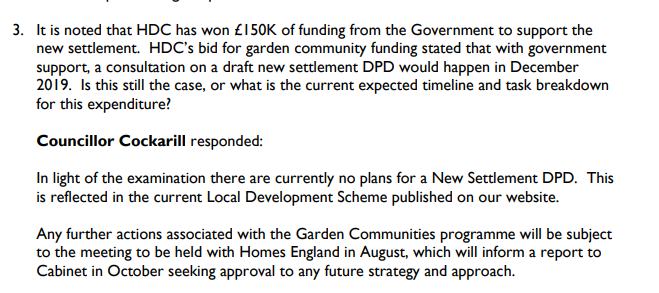
Hart Council Knows Nothing: No plan for New Settlement DPD
Appendix D – Deceptive Communications
Statement at Hart Cabinet in July that both Homes England and MHCLG were informed:

Winchfield fights back: Chairman Announcement MHCLG kept informed
Question asking how MHCLG and Homes England were kept informed of the changing status of the New Settlement in Policy SS3 in the Hart Local Plan.
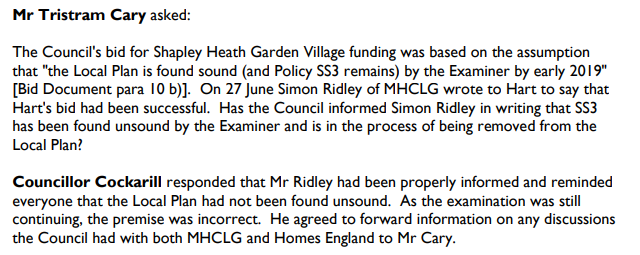
Winchfield fights back: Cockarill MHCLG and civil servant kept informed
The subsequent release of correspondence shows only one email to Kevin Bourner informing him in passing of the removal of Policy SS3. This can be found here.
Key passage:
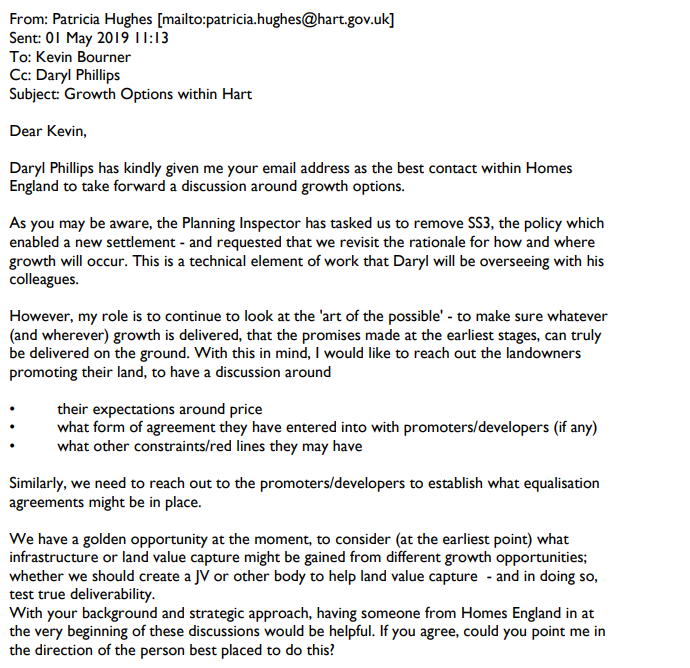
Winchfield fights back: HDC email to Homes England
The only correspondence with MHCLG prior to the announcement is asking for an update on the announcement timetable. This email is not addressed to Simon Ridley who made the award.
